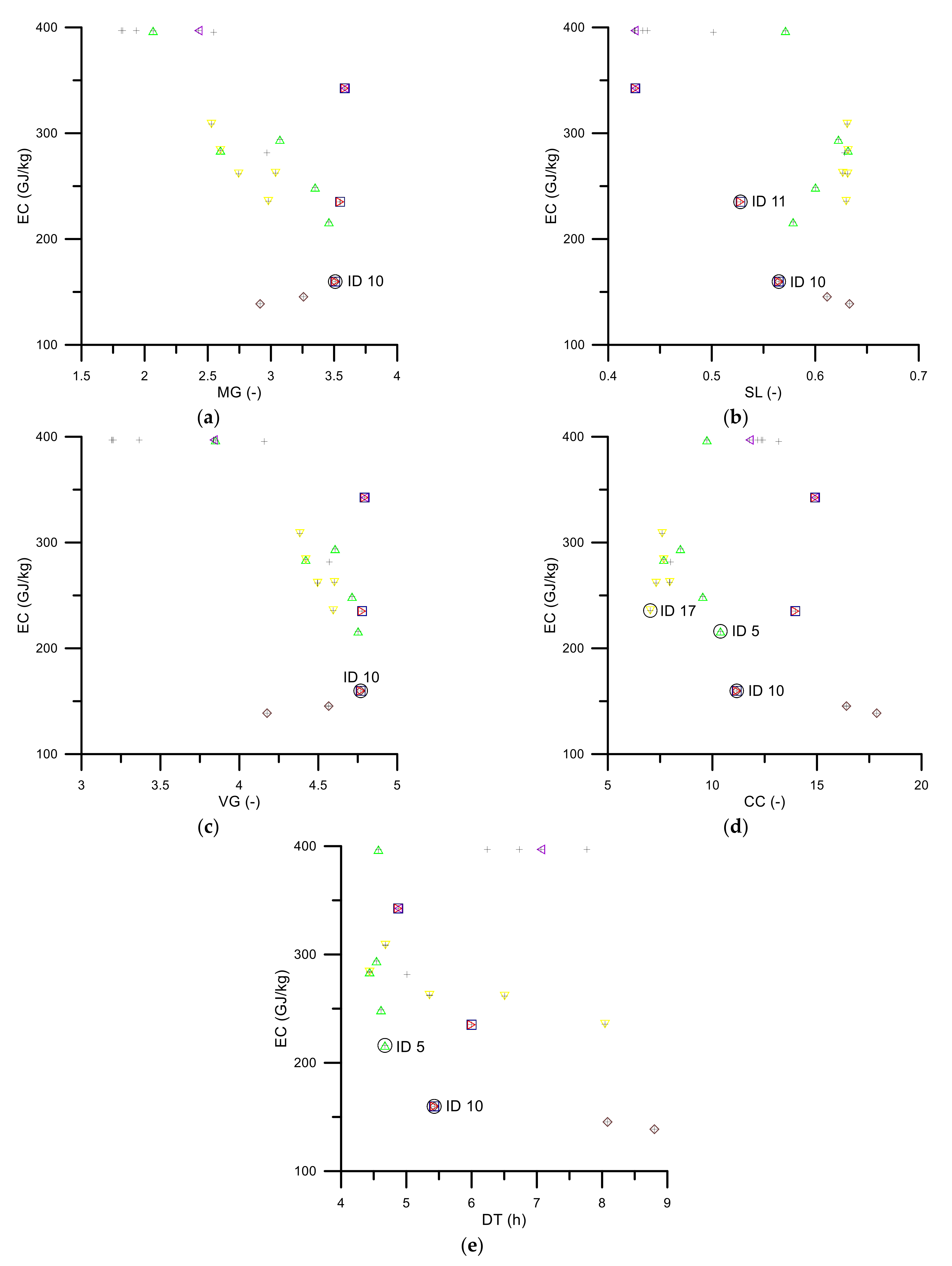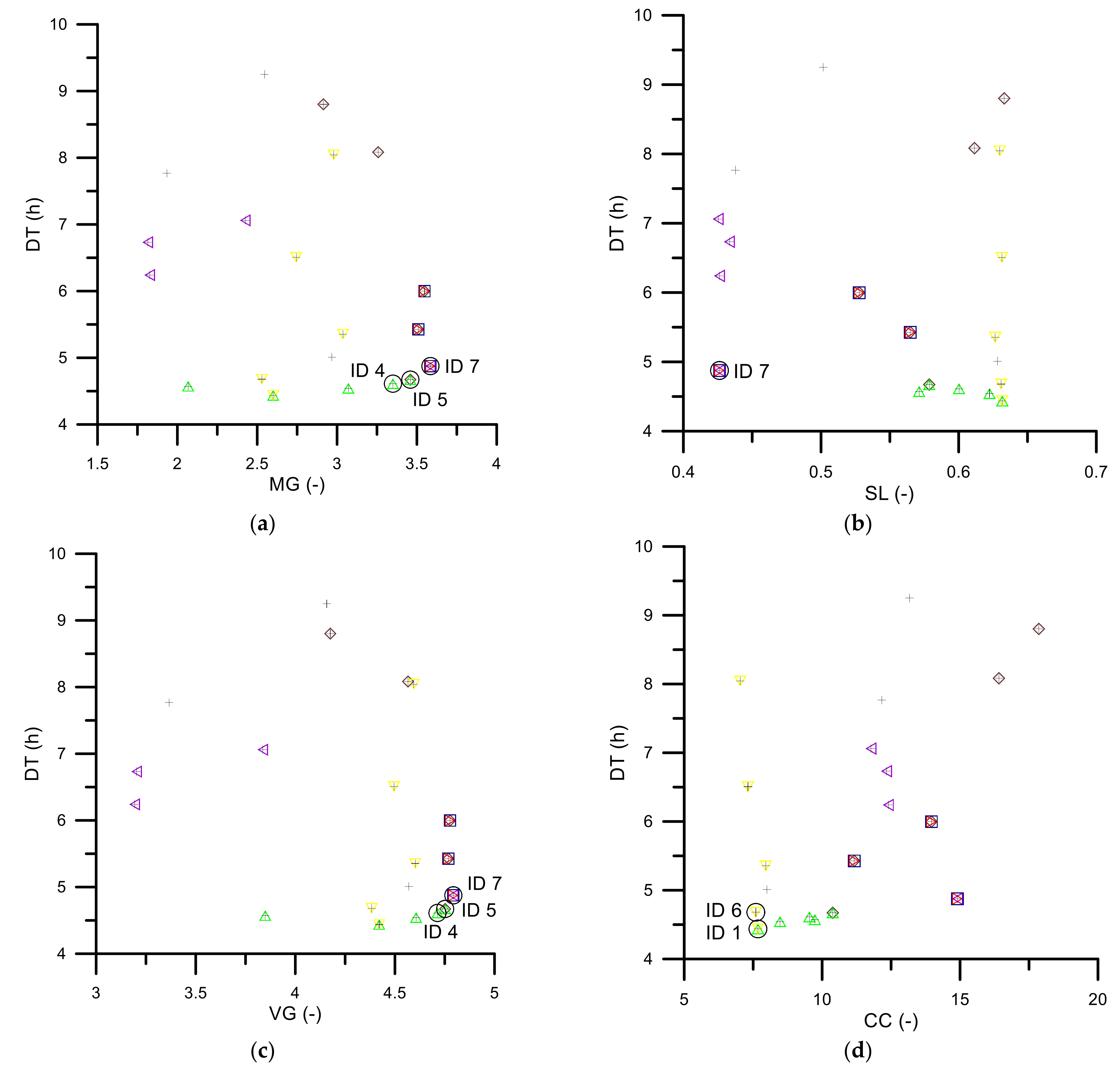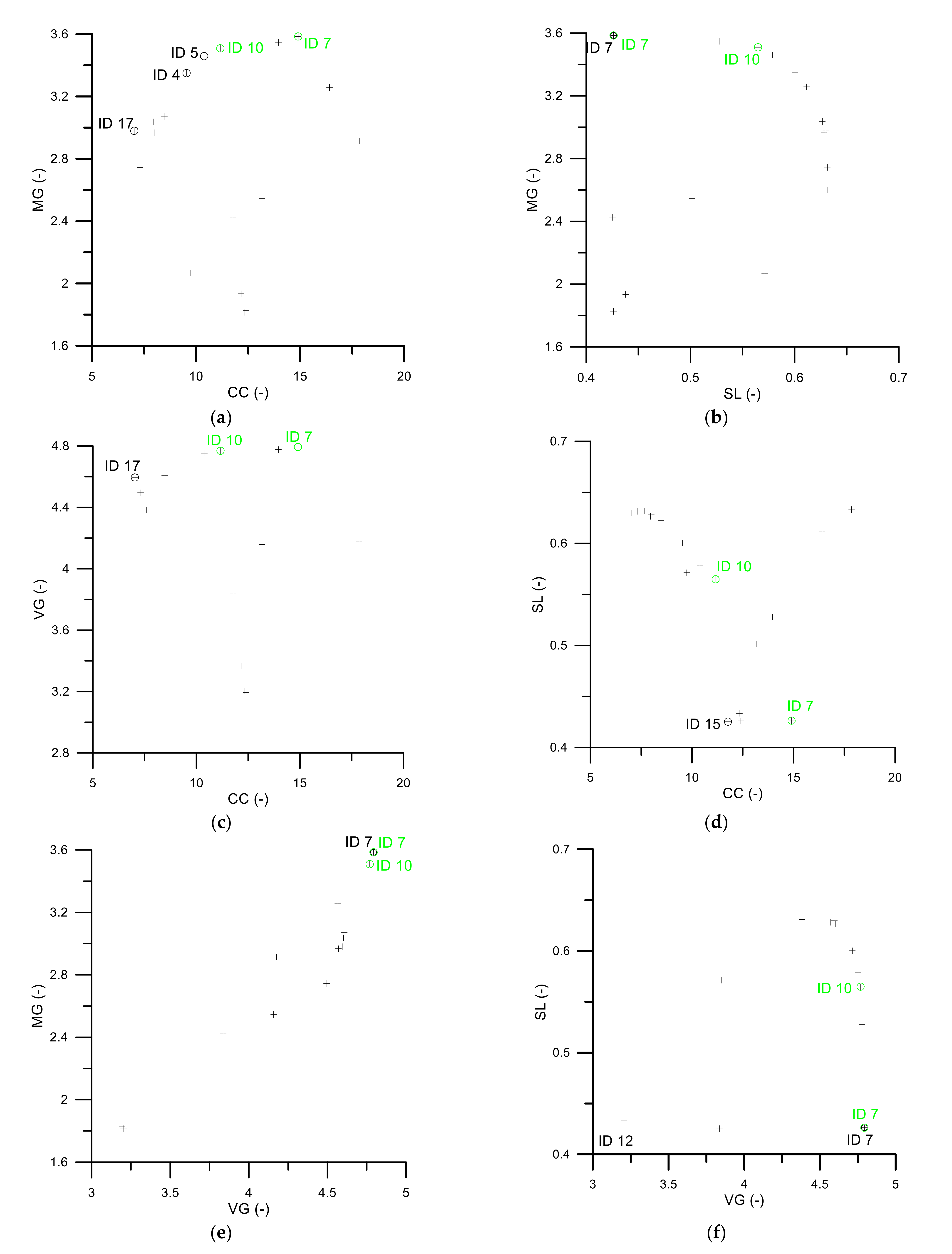Application of a MOGA Algorithm and ANN in the Optimization of Apple Drying and Rehydration Processes
Abstract
:1. Introduction
2. Materials and Methods
2.1. Materials
- For slices CD = s;
- For cubes ;
2.2. Drying
2.3. Rehydration
2.4. Mass and Volume
2.5. Color
2.6. Energy Consumption EC
2.7. Quality Parameters QP
2.8. QP, DT, and EC Modeling Using the Artificial Neural Network
2.9. Optimization Problem
3. Results and Discussion
3.1. ANN
3.2. MOGA
4. Conclusions
Author Contributions
Funding
Institutional Review Board Statement
Informed Consent Statement
Data Availability Statement
Conflicts of Interest
References
- Bora, G.C.; Pathak, R.; Ahmadi, M.; Mistry, P. Image Processing Analysis to Track Colour Changes on Apple and Correlate to Moisture Content in Drying Stages. Food Qual. Saf. 2018, 2, 105–110. [Google Scholar] [CrossRef] [Green Version]
- Sinha, N.K. Apples. In Handbook of Fruits and Fruit Processing; Hui, Y.H., Ed.; Blackwell Publishing: Ames, IA, USA, 2006; pp. 263–278. ISBN 978-0-470-27773-7. [Google Scholar]
- Park, Y.; Chang, Y.-S.; Park, J.-H.; Yang, S.-Y.; Chung, H.; Jang, S.-K.; Choi, I.-G.; Yeo, H. Energy Efficiency of Fluidized Bed Drying for Wood Particles. J. Korean Wood Sci. Technol. 2016, 44, 821–827. [Google Scholar] [CrossRef] [Green Version]
- Syahrul, S.; Hamdullahpur, F.; Dincer, I. Exergy Analysis of Fluidized Bed Drying of Moist Particles. Exergy Int. J. 2002, 2, 87–98. [Google Scholar] [CrossRef]
- Midilli, A.; Kucuk, H. Energy and Exergy Analyses of Solar Drying Process of Pistachio. Energy 2003, 28, 539–556. [Google Scholar] [CrossRef]
- Motevali, A.; Minaei, S.; Khoshtagaza, M.H. Evaluation of Energy Consumption in Different Drying Methods. Energy Convers. Manag. 2011, 52, 1192–1199. [Google Scholar] [CrossRef]
- Nazghelichi, T.; Aghbashlo, M.; Kianmehr, M.H. Optimization of an Artificial Neural Network Topology Using Coupled Response Surface Methodology and Genetic Algorithm for Fluidized Bed Drying. Comput. Electron. Agric. 2011, 75, 84–91. [Google Scholar] [CrossRef]
- Tremblay, C.; Zhou, D. A Study of Efficient Drying Parameters for Bed Dryers. In Proceedings of the 2nd International Conference on Fluid Flow, Heat and Mass Transfer, Ottawa, ON, Canada, 30 April–1 May 2015; p. 179. [Google Scholar]
- Chaudhari, A.R.; Kostha, V.; Upadhyay, J.B. Optimum Energy Requirement of Fluidized Bed Dryer for Drying of Khoa. Int. J. Chem. Stud. 2018, 6, 40–44. [Google Scholar]
- Zlatanović, I.; Komatina, M.; Antonijević, D. Low-temperature convective drying of apple cubes. Appl. Therm. Eng. 2013, 53, 114–123. [Google Scholar] [CrossRef]
- Seiiedlou, S.; Ghasemzadeh, H.R.; Hamdami, N.; Talati, F.; Moghaddam, M. Convective Drying of Apple: Mathematical Modeling and Determination of some Quality Parameters. Int. J. Agric. Biol. 2010, 12, 171–178. [Google Scholar]
- Figiel, A. Dehydration of apples by a combination of convective and vacuum-microwave drying. Pol. J. Food Nutr. Sci. 2007, 57, 131–135. [Google Scholar]
- Chong, C.H.; Figiel, A.; Law, C.L.; Wojdyło, A. Combined Drying of Apple Cubes by Using of Heat Pump, Vacuum-Microwave, and Intermittent Techniques. Food Bioprocess Technol. 2014, 7, 975–989. [Google Scholar] [CrossRef] [Green Version]
- Pasławska, M.; Stępień, B.; Nawirska-Olszańska, A.; Maślankowski, R.; Rydzak, L. Effect of Vacuum Impregnation on Drying Kinetics and Selected Quality Factors of Apple Cubes. Int. J. Food Eng. 2017, 13, 20160309. [Google Scholar] [CrossRef]
- Diamante, L.M.; Yamaguchi, Y. Response surface methodology for optimisation of hot air drying of blackcurrant concentrate infused apple cubes. Int. Food Res. J. 2012, 19, 353–362. [Google Scholar]
- Assis, F.R.; Morais, R.M.S.C.; Morais, A.M.M.B. Rehydration of osmotically pre-treated apple cubes dried by hot air, microwave, and freeze-drying. Acta Alim. 2018, 47, 315–323. [Google Scholar] [CrossRef] [Green Version]
- Kraśniewska, K.; Ścibisz, I.; Gniewosz, M.; Mitek, M.; Pobiega, K.; Cendrowski, A. Effect of Pullulan Coating on Postharvest Quality and Shelf-Life of Highbush Blueberry (Vaccinium Corymbosum L.). Materials 2017, 10, 965. [Google Scholar] [CrossRef]
- Zhang, J.-W.; Liu, H.-H.; Yang, H.; Yang, L. Drying Characteristics of Eucalyptus Urophylla × E. Grandis with Supercritical CO2. Materials 2020, 13, 3989. [Google Scholar] [CrossRef] [PubMed]
- Górnicki, K.; Kaleta, A. Drying Curve Modelling of Blanched Carrot Cubes under Natural Convection Condition. J. Food Eng. 2007, 82, 160–170. [Google Scholar] [CrossRef]
- Nayak, C.A.; Suguna, K.; Rastogi, N.K. Combined Effect of Gamma-Irradiation and Osmotic Treatment on Mass Transfer during Rehydration of Carrots. J. Food Eng. 2006, 74, 134–142. [Google Scholar] [CrossRef]
- Lewicki, P.P. Some Remarks on Rehydration of Dried Foods. J. Food Eng. 1998, 36, 81–87. [Google Scholar] [CrossRef]
- Funebo, T.; Ohlsson, T. Microwave-Assisted Air Dehydration of Apple and Mushroom. J. Food Eng. 1998, 38, 353–367. [Google Scholar] [CrossRef]
- Sacilik, K.; Elicin, A.K. The Thin Layer Drying Characteristics of Organic Apple Slices. J. Food Eng. 2006, 73, 281–289. [Google Scholar] [CrossRef]
- Krokida, M.K.; Philippopoulos, C. Rehydration of Dehydrated Foods. Dry. Technol. 2005, 23, 799–830. [Google Scholar] [CrossRef]
- McMinn, W.A.M.; Magee, T.R.A. Quality and Physical Structure of a Dehydrated Starch-Based System. Dry. Technol. 1997, 15, 1961–1971. [Google Scholar] [CrossRef]
- Mulet, A.; Cárcel, J.A.; Sanjuán, N.; Bon, J. New Food Drying Technologies—Use of Ultrasound. Food Sci. Technol. Int. 2003, 9, 215–221. [Google Scholar] [CrossRef]
- Holland, J.H. Adaptation in Natural and Artificial Systems; University of Michigan Press: Ann Arbor, MI, USA, 1975. [Google Scholar]
- Goldberg, D. Genetic Algorithms in Search, Optimization, and Machine Learning; Addison-Wesley: Boston, MA, USA, 1989. [Google Scholar]
- Michalewicz, Z. Genetic Algorithms + Data Structures = Evolution Programs; Springer: Berlin, Germany, 1992. [Google Scholar]
- Davis, L. Handbook of Genetic Algorithms; Van Nostrand Reinhold: New York, NY, USA, 1991. [Google Scholar]
- Winiczenko, R.; Górnicki, K.; Kaleta, A.; Martynenko, A.; Janaszek-Mańkowska, M.; Trajer, J. Multi-Objective Optimization of Convective Drying of Apple Cubes. Comput. Electron. Agric. 2018, 145, 341–348. [Google Scholar] [CrossRef]
- Winiczenko, R.; Górnicki, K.; Kaleta, A.; Janaszek-Mańkowska, M.; Choińska, A.; Trajer, J. Apple Cubes Drying and Rehydration. Multiobjective Optimization of the Processes. Sustainability 2018, 10, 4126. [Google Scholar] [CrossRef] [Green Version]
- Darvishi, H.; Farhudi, Z.; Behroozi-Khazaei, N. Multi-Objective Optimization of Savory Leaves Drying in Continuous Infrared-Hot Air Dryer by Response Surface Methodology and Desirability Function. Comput. Electron. Agric. 2020, 168, 105112. [Google Scholar] [CrossRef]
- Luikov, A.V. Analytical Heat Diffusion Theory; Academic: New York, NY, USA, 1968. [Google Scholar]
- Colorimetry, 3rd ed; Internationale Beleuchtungskommission, Technical Report; CIE, Central Bureau: Vienna, Austria, 2004; ISBN 978-3-901906-33-6.
- Schanda, J. CIE Colorimetry. In Colorimetry: Understanding the CIE System; Schanda, J., Ed.; John Wiley & Sons, Inc.: Hoboken, NJ, USA, 2007; pp. 25–78. ISBN 978-0-470-17563-7. [Google Scholar]
- Motevli, A.; Minaei, S.; Banakar, A.; Ghobadian, B.; Khoshtaghaza, M.H. Comparison of energy parameters in various dryers. Energy Convers. Manag. 2014, 87, 711–725. [Google Scholar] [CrossRef]
- Nadi, F.; Górnicki, K.; Winiczenko, R. A novel optimization algorithm for Echium amoenum petals drying. Appl. Sci. 2020, 10, 8387. [Google Scholar] [CrossRef]
- Vieira, M.G.A.; Estrella, L.; Rocha, S.C.S. Energy Efficiency and Drying Kinetics of Recycled Paper Pulp. Dry. Technol. 2007, 25, 1639–1648. [Google Scholar] [CrossRef]
- Fausett, L.V. Fundamentals of Neural Networks: Architectures, Algorithms, and Applications; Prentice-Hall: Englewood Cliffs, NJ, USA, 1994; ISBN 978-0-13-334186-7. [Google Scholar]
- Barr, A.; Feigenbaum, E. The Handbook of Artificial Intelligence; Addison-Wesley: New York, NY, USA, 1989; Volume 3. [Google Scholar]
- Kung, S. Digital Neural Networks; Prentice-Hall: Englewood Cliffs, NJ, USA, 1993. [Google Scholar]
- Omid, M.; Baharlooei, A.; Ahmadi, H. Modeling drying kinetics of pistachio nuts with multi-layer feed-forward neural network. Dry. Technol. 2009, 27, 1069–1077. [Google Scholar] [CrossRef]

 —ECmin,
—ECmin,  —MGmax,
—MGmax,  —DTmin,
—DTmin,  —CCmin,
—CCmin,  —VGmax-,
—VGmax-,  —SLmin.
—SLmin.
 —ECmin,
—ECmin,  —MGmax,
—MGmax,  —DTmin,
—DTmin,  —CCmin,
—CCmin,  —VGmax-,
—VGmax-,  —SLmin.
—SLmin.
 —ECmin,
—ECmin,  —MGmax,
—MGmax,  —DTmin,
—DTmin,  —CCmin,
—CCmin,  —VGmax-,
—VGmax-,  —SLmin.
—SLmin.
 —ECmin,
—ECmin,  —MGmax,
—MGmax,  —DTmin,
—DTmin,  —CCmin,
—CCmin,  —VGmax-,
—VGmax-,  —SLmin.
—SLmin.

| Parameters | Equation No. |
|---|---|
| (4) | |
| (5) | |
| (6) | |
| (7) |
| ID. | Activate Function in the Hidden Layer | Number of Neurons in the Hidden Layer | Activate Function in the Output Layer | Statistical Analysis | ||
|---|---|---|---|---|---|---|
| MSE | R | Adjusted R-Square | ||||
| 1 | 4 | 0.002020 | 0.9914 | 0.9820 | ||
| 2 | 6 | log-sigmoid | 0.000309 | 0.9914 | 0.9820 | |
| 3 | log-sigmoid | 8 | 0.001207 | 0.0990 | 0.0430 | |
| 4 | 4 | 0.001664 | 0.9886 | 0.9761 | ||
| 5 | 6 | pureline | 0.000825 | 0.9917 | 0.9826 | |
| 6 | 8 | 0.001983 | 0.9944 | 0.9883 | ||
| 7 | 4 | 0.003444 | 0.9853 | 0.9693 | ||
| 8 | 6 | pureline | 0.000970 | 0.9931 | 0.9855 | |
| 9 | tansig | 8 | 0.000952 | 0.9950 | 0.9895 | |
| 10 | 4 | 0.003110 | 0.9706 | 0.9390 | ||
| 11 | 6 | log-sigmoid | 0.004624 | 0.9743 | 0.9466 | |
| 12 | 8 | 0.000520 | 0.9953 | 0.9901 | ||
| ID | Inputs | Outputs | ||||||||
|---|---|---|---|---|---|---|---|---|---|---|
| Td (°C) | vd (m/s) | CD (mm) | Tr (°C) | MG (-) | SL (-) | VG (-) | CC (-) | DT (h) | EC (GJ/kg) | |
| 1 | 62.44 | 1.2594 | 3.5581 | 56.41 | 2.60 | 0.63 | 4.42 | 7.67 | 4.44 | 283.84 |
| 2 | 66.99 | 1.6903 | 3.1241 | 37.41 | 3.07 | 0.62 | 4.61 | 8.47 | 4.54 | 294.00 |
| 3 | 60.48 | 1.2513 | 4.2814 | 47.66 | 2.07 | 0.57 | 3.85 | 9.74 | 4.57 | 396.82 |
| 4 | 66.64 | 1.4174 | 2.8837 | 50.61 | 3.35 | 0.60 | 4.71 | 9.54 | 4.61 | 248.83 |
| 5 | 64.98 | 1.2986 | 2.6938 | 56.03 | 3.46 | 0.58 | 4.75 | 10.39 | 4.67 | 216.07 |
| 6 | 60.28 | 1.3288 | 3.5348 | 44.76 | 2.53 | 0.63 | 4.38 | 7.60 | 4.68 | 308.62 |
| 7 | 62.11 | 1.6584 | 2.0158 | 47.86 | 3.59 | 0.43 | 4.79 | 14.91 | 4.88 | 342.51 |
| 8 | 55.33 | 1.7493 | 2.5717 | 42.51 | 2.97 | 0.63 | 4.57 | 8.00 | 5.10 | 281.57 |
| 9 | 55.75 | 1.5048 | 2.6483 | 57.37 | 3.04 | 0.63 | 4.60 | 7.96 | 5.36 | 262.38 |
| 10 | 56.10 | 1.2456 | 1.9942 | 59.16 | 3.51 | 0.57 | 4.77 | 11.16 | 5.43 | 159.80 |
| 11 | 53.83 | 1.5361 | 1.5146 | 48.42 | 3.55 | 0.53 | 4.78 | 13.96 | 6.00 | 235.15 |
| 12 | 63.85 | 1.3485 | 5.7152 | 55.26 | 1.83 | 0.43 | 3.19 | 12.40 | 6.24 | 396.98 |
| 13 | 60.81 | 0.7190 | 3.3839 | 45.81 | 2.74 | 0.63 | 4.50 | 7.31 | 6.51 | 261.63 |
| 14 | 64.24 | 1.2258 | 5.6621 | 51.41 | 1.82 | 0.43 | 3.20 | 12.33 | 6.73 | 396.98 |
| 15 | 58.02 | 1.8172 | 5.1563 | 46.69 | 2.43 | 0.43 | 3.84 | 11.77 | 7.06 | 396.98 |
| 16 | 64.45 | 1.1341 | 5.6831 | 47.77 | 1.93 | 0.44 | 3.37 | 12.17 | 7.77 | 396.98 |
| 17 | 59.07 | 0.6460 | 3.2791 | 54.20 | 2.98 | 0.63 | 4.60 | 7.03 | 8.04 | 235.70 |
| 18 | 55.53 | 1.1483 | 1.5125 | 31.98 | 3.26 | 0.61 | 4.57 | 16.41 | 8.08 | 145.40 |
| 19 | 53.81 | 0.9368 | 1.5520 | 41.26 | 2.91 | 0.63 | 4.18 | 17.86 | 8.80 | 138.71 |
| Validation | Quality of Rehydrated Apples | |||||
|---|---|---|---|---|---|---|
| MG | SL | VG | CC | DT | EC | |
| Experimental values () | 3.48 | 0.59 | 4.68 | 11.7 | 5.3 | 162 |
| Predicted values () | 3.51 | 0.57 | 4.77 | 11.2 | 5.4 | 159.8 |
| Errors = % | 0.85 | 3.5 | 1.88 | 4.46 | 1.85 | 1.38 |
Publisher’s Note: MDPI stays neutral with regard to jurisdictional claims in published maps and institutional affiliations. |
© 2021 by the authors. Licensee MDPI, Basel, Switzerland. This article is an open access article distributed under the terms and conditions of the Creative Commons Attribution (CC BY) license (https://creativecommons.org/licenses/by/4.0/).
Share and Cite
Winiczenko, R.; Kaleta, A.; Górnicki, K. Application of a MOGA Algorithm and ANN in the Optimization of Apple Drying and Rehydration Processes. Processes 2021, 9, 1415. https://doi.org/10.3390/pr9081415
Winiczenko R, Kaleta A, Górnicki K. Application of a MOGA Algorithm and ANN in the Optimization of Apple Drying and Rehydration Processes. Processes. 2021; 9(8):1415. https://doi.org/10.3390/pr9081415
Chicago/Turabian StyleWiniczenko, Radosław, Agnieszka Kaleta, and Krzysztof Górnicki. 2021. "Application of a MOGA Algorithm and ANN in the Optimization of Apple Drying and Rehydration Processes" Processes 9, no. 8: 1415. https://doi.org/10.3390/pr9081415
APA StyleWiniczenko, R., Kaleta, A., & Górnicki, K. (2021). Application of a MOGA Algorithm and ANN in the Optimization of Apple Drying and Rehydration Processes. Processes, 9(8), 1415. https://doi.org/10.3390/pr9081415








